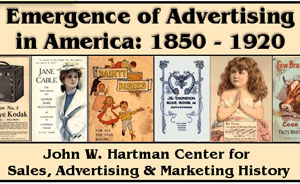talking history | syllabi | students | teachers | puzzle | about us
Emergence of Advertising in America: 1850–1920
http://library.duke.edu/digitalcollections/eaa/
Created and maintained by the Digital Scriptorium and the John W. Hartman Center for Sales, Advertising, and Marketing History, Rare Book, Manuscript and Special Collections Library, Duke University.
Reviewed Dec. 4–15, 2006.
In recent decades advertisements have become key primary sources, both for studying business history and for shedding light on social and cultural patterns. Duke University’s John W. Hartman Center for Sales, Advertising, and Marketing History has made over nine thousand advertising images available on its skillfully designed Web site, Emergence of Advertising in America. The online material represents a small fraction of the holdings of the Hartman Center; the site directs researchers to the center’s other online and hard copy resources and to advertising history archives elsewhere.

Emergence of Advertising in America provides access to eleven collections of advertising material. The largest contains over thirty-five hundred images of advertising ephemera, such as trade cards, calendars, and postcards. The collections can be browsed. One might start with carriages and buggies, move on to bicycles, and then examine automobile items. The contents of other categories range from fifty books on advertising to 564 photos of billboards and other outdoor ads, drawn from Duke’s collection of over thirty-five thousand pictures. Collections of “Kodakiana” and ads for Lux soap flakes and for Pond’s medicinal, beauty, and shaving products trace the promotion of prominent brands over time.
Global keyword searches find items in all eleven categories. One can also, for example, search for all ads that contain images of Africans or African Americans or all those that use testimonials. Within each category, one can search on complex criteria. One could look at ephemera with illustrations of children in the 1880s and compare them with items depicting children in the 1910s. Another search would reveal 108 references to sports figures in the tobacco products collection. A third would find the actresses, socialites, and physicians who provided testimonials for Pond’s cold cream.
One notable feature of the site is the breadth of media included. Conventional research on the history of advertising has made use of newspaper and magazine ads found in libraries and archival clippings files. Scholars such as Pamela Walker Laird and Catherine Gudis have called our attention to ads ranging from trade cards to billboards (making use of the Hartman Center’s collections); Emergence of Advertising in America reminds us of the significance of those less-studied sources.
Without context, advertisements can be hard to understand. Undergraduates, in particular, will need to learn about the business motives of the advertisers and the editorial matter that surrounded newspaper and magazine advertisements. Fortunately, the site provides informative, well-researched essays that accompany each of the collections; all but one were written by the now-retired center director Ellen Gartrell. Students and other researchers should consult those essays before delving into the ads. Another issue in the study of advertising history is less readily resolved. How did consumers react to these advertisements? Several businessmen in the years covered in the site were credited with observing that half of their advertising budget was wasted: the problem was, they could not tell which half. One collection, containing four scrapbooks in which individuals or families pasted advertisements along with other ephemeral items, does deliver some clues about consumer reception. Without more information on the compilers, the scrapbooks remain tantalizing but fragmentary evidence of how people responded to ads.
In sum, Emergence of Advertising in America gives us an important window into American advertising as it grew from a peripheral to a central aspect of business and culture. These online collections will surely continue to beckon scholars into new and improved research in the history of advertising.
Daniel Pope
University of Oregon
Eugene, Oregon
